Section 6.3 : Volume With Rings
5. Use the method of disks/rings to determine the volume of the solid obtained by rotating the region bounded by \(y = 6{{\bf{e}}^{ - 2x}}\) and \(y = 6 + 4x - 2{x^2}\) between \(x = 0\) and \(x = 1\) about the line \(y = - 2\).
Show All Steps Hide All Steps
We need to start the problem somewhere so let’s start “simple”.
Knowing what the bounded region looks like will definitely help for most of these types of problems since we need to know how all the curves relate to each other when we go to set up the area formula and we’ll need limits for the integral which the graph will often help with.
Here is a sketch of the bounded region with the axis of rotation shown.
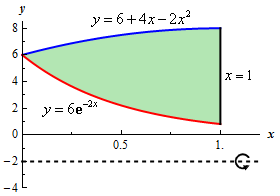
For the intersection point on the left a quick check by plugging \(x = 0\) into both equations shows that the intersection point is in fact \(\left( {0,6} \right)\) as we might have guessed from the graph. We’ll be needing this point in a bit. From the sketch of the region it is also clear that there is no intersection point on the right.
Note that this can be a difficult thing to do especially if you aren’t a very visual person. However, having a representative ring can be of great help when we go to write down the area formula. Also, getting the representative ring can be difficult without a sketch of the solid of revolution. So, do the best you can at getting these sketches.
Here is a sketch of the solid of revolution.
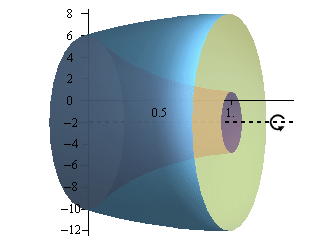
Here are a couple of sketches of a representative ring. The image on the left shows a representative ring with the front half of the solid cut away and the image on the right shows a representative ring with a “wire frame” of the back half of the solid (i.e. the curves representing the edges of the of the back half of the solid).
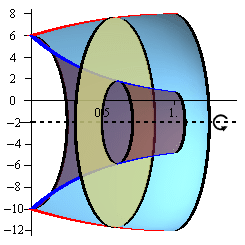
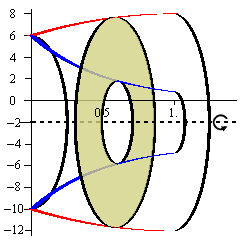
We now need to find a formula for the area of the ring. Because we are using rings that are centered on a horizontal axis (i.e. parallel to the \(x\)-axis) we know that the area formula will need to be in terms of \(x\). Therefore, the equations of the curves will need to be in terms of \(x\) (which in this case they already are).
Here is another sketch of a representative ring with all of the various quantities we need put into it.
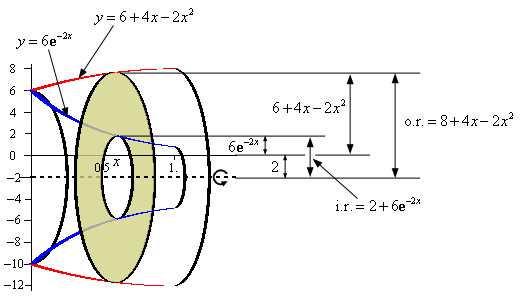
From the sketch we can see the ring is centered on the line \(y = - 2\) and placed at some \(x\).
The inner radius of the ring is the distance from the axis of rotation to the \(x\)-axis (a distance of 2) followed by the distance from the \(x\)-axis to the curve defining the inner edge of the solid (a distance of \(6{{\bf{e}}^{ - 2x}}\)).
Likewise, the outer radius of the ring is the distance from the axis of rotation to the \(x\)-axis (again, a distance of 2) followed by the distance from the \(x\)-axis to the curve defining the outer edge of the solid (a distance of \(6 + 4x - 2{x^2}\)).
So, the inner and outer radii are,
\[{\mbox{Inner Radius}} = 2 + 6{{\bf{e}}^{ - 2x}}\hspace{0.5in}{\mbox{Outer Radius}} = 2 + 6 + 4x - 2{x^2} = 8 + 4x - 2{x^2}\]The area of the ring is then,
\[\begin{align*}A\left( x \right) & = \pi \left[ {{{\left( {{\mbox{Outer Radius}}} \right)}^2} - {{\left( {{\mbox{Inner Radius}}} \right)}^2}} \right]\\ & = \pi \left[ {{{\left( {8 + 4x - 2{x^2}} \right)}^2} - {{\left( {2 + 6{{\bf{e}}^{ - 2x}}} \right)}^2}} \right]\\ & = \pi \left( {60 + 64x - 16{x^2} - 16{x^3} + 4{x^4} - 24{{\bf{e}}^{ - 2x}} - 36{{\bf{e}}^{ - 4x}}} \right)\end{align*}\] Show Step 4The final step is to then set up the integral for the volume and evaluate it.
From the graph from Step 1 we can see that the “first” ring in the solid would occur at \(x = 0\) and the “last” ring would occur at \(x = 1\). Our limits are then : \(0 \le x \le 1\).
The volume is then,
\[\begin{align*}V & = \int_{0}^{1}{{\pi \left( {60 + 64x - 16{x^2} - 16{x^3} + 4{x^4} - 24{{\bf{e}}^{ - 2x}} - 36{{\bf{e}}^{ - 4x}}} \right)\,dx}}\\ & = \left. {\pi \left( {60x + 32{x^2} - \frac{{16}}{3}{x^3} - 4{x^4} + \frac{4}{5}{x^5} + 12{{\bf{e}}^{ - 2x}} + 9{{\bf{e}}^{ - 4x}}} \right)} \right|_0^1 = \require{bbox} \bbox[2pt,border:1px solid black]{{\left( {\frac{{937}}{{15}} + 12{{\bf{e}}^{ - 2}} + 9{{\bf{e}}^{ - 4}}} \right)\pi }}\end{align*}\]